Family name: Rutaceae Jussieu
Synonym(s): Amyridaceae Kunth; Aurantiaceae Juss.; Boroniaceae J. Agardh; Cneoraceae Vest, nom. cons.; Correaceae J. Agardh, nom. inval.; Cuspariaceae Tratt., nom. illeg.; Dictamnaceae Vest; Diosmaceae R. Br. ex Bartl.; Diplolaenaceae J. Agardh; Flindersiaceae C. T. White ex Airy Shaw; Fraxinellaceae Nees & Mart., nom. illeg.; Pilocarpaceae J. Agardh; Ptaeroxylaceae J.-F. Leroy; Pteleaceae Kunth; Zanthoxylaceae Martinov
Common name(s): rue or citrus family
*Number of genera/species: 176/2,070
List of genera records in GRIN-Global
For help identifying Citrus, see the Citrus ID tool.
Fruit a berryberry:
an indehiscent, fleshy fruit with one or a few to many seeds. The flesh may be homogenous throughout. Or, if the outer part is hard, firm, or leathery, referred to as an hesperidium. Septa are present in some, and the seeds may be arillate or with a fleshy testa.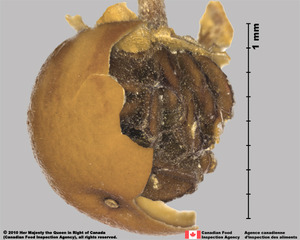 (hesperidiumhesperidium:
(hesperidiumhesperidium:
a specialized berry, derived from a compound ovary, in which the outer layer is hard, firm, or leathery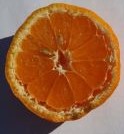 ), drupedrupe:
), drupedrupe:
(indehiscent drupe) a fleshy, indehiscent fruit with one more hard pits enclosing seeds, derived from single, superior, simple or compound ovary; (dehiscent drupe) a fruit with a dry or fibrous to fleshy or leathery outer husk that early to tardily breaks apart (or opens), exposing one or more nutlike pits enclosing the seeds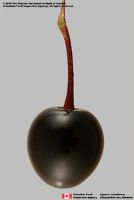 , samarasamara:
, samarasamara:
a winged, indehiscent, dry fruit containing a single (rarely two) seed(s)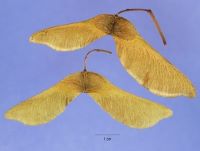 , loculicidalloculicidal:
, loculicidalloculicidal:
type of capsular dehiscence, opening longitudinally through the locules (compare septicidal)
 capsulecapsule:
capsulecapsule:
a dry, dehiscent fruit derived from a compound ovary , rarely septicidalsepticidal:
, rarely septicidalsepticidal:
type of capsular dehiscence, opening longitudinally by separating between the septa of adjacent carpels
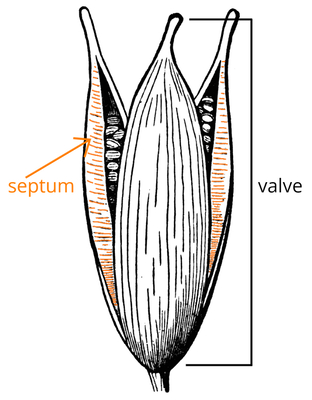 , folliclefollicle:
, folliclefollicle:
a dry to (rarely) fleshy fruit derived from a single carpel that opens along a single longitudinal suture, derived from a single, superior, simple ovary; the seeds may be arillate or with a fleshy testa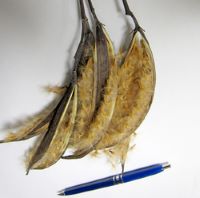 (1–5 distinct or basally connate), or schizocarpschizocarp:
(1–5 distinct or basally connate), or schizocarpschizocarp:
usually dry fruit splitting between two or more locules to form distinct, indehiscent, usually one seeded segments; fruit derived from a single, superior or inferior, compound ovary; compare to mericarp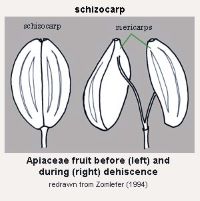 splitting into drupeletsdrupelet:
splitting into drupeletsdrupelet:
one drupe of a fruit with multiple drupes, as in blackberries
, samarassamara:
a winged, indehiscent, dry fruit containing a single (rarely two) seed(s) , or follicle-like fruits, 2.5–150 mm long, globoseglobose:
, or follicle-like fruits, 2.5–150 mm long, globoseglobose:
3D shape—more or less spherical to angularangular:
to angularangular:
2D shape—having sides that meet at acute or obtuse angles
, tereteterete:
approximately circular in cross section; width and thickness approximately equal
 or flattened in transection, often with stylar beakbeak:
or flattened in transection, often with stylar beakbeak:
a usually firm, terminal appendage, sometimes tapered (Toddalioideae), sometimes winged (broad encompassing wing, winged at both ends, or terminal wing), with one to many seeds. Pericarppericarp:
(Toddalioideae), sometimes winged (broad encompassing wing, winged at both ends, or terminal wing), with one to many seeds. Pericarppericarp:
fruit wall or fruit coat
blue, black, purple, green, red, orange, yellow, or cream, in berriesberry:
an indehiscent, fleshy fruit with one or a few to many seeds. The flesh may be homogenous throughout. Or, if the outer part is hard, firm, or leathery, referred to as an hesperidium. Septa are present in some, and the seeds may be arillate or with a fleshy testa. pulp color may differ from epicarpepicarp:
pulp color may differ from epicarpepicarp:
outer layer of fruit wall or pericarp, if divided into layers; note here used synonymously with exocarp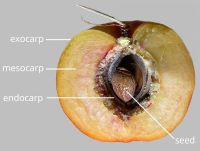 , texture variable, glabrousglabrous:
, texture variable, glabrousglabrous:
without hairs
or pubescent, smooth or gland-dotted, groovedgrooved:
surface relief—linear depressions that may be single or form a series of grooves over the surface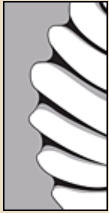 , keeledkeel:
, keeledkeel:
a longitudinal ridge, like the keel of a boat, formed by the lengthwise folding of a structure, such as a lemma or palea
 , ribbedribbed:
, ribbedribbed:
surface relief—wide, prominent, linear ridges that are generally rounded and longitudinally situated on the surface , wartywarty:
, wartywarty:
surface relief—distinct, rounded projections that are large relative to the fruit size; tuberculate, verrucose (small to large warts), wrinkledwrinkled:
(small to large warts), wrinkledwrinkled:
surface relief—shallow, irregular folds and furrows covering the surface; appearing overall though crumpled and then spread out , pittedpitted:
, pittedpitted:
surface relief—surface with small depressions in which the areas between the hollows do not take on the appearance of a true reticular net , punctatepunctate:
, punctatepunctate:
surface relief - dotted with pits or with translucent, sunken glands or with colored dots, similar to pitted , or with hornshorn:
, or with hornshorn:
a straight or curved, slenderly conic or conoidal protrusion, resembling an animal horn
or prickles. Seed sometimes explosively ejected.
Fruit type by subfamily
Aurantioideae: BerriesBerry:
an indehiscent, fleshy fruit with one or a few to many seeds. The flesh may be homogenous throughout. Or, if the outer part is hard, firm, or leathery, referred to as an hesperidium. Septa are present in some, and the seeds may be arillate or with a fleshy testa. , dry or fleshy with thick and hard or thin and leatheryleathery:
, dry or fleshy with thick and hard or thin and leatheryleathery:
texture—moderately thick, tough, and very pliable
epicarpepicarp:
outer layer of fruit wall or pericarp, if divided into layers; note here used synonymously with exocarp . The mesocarpmesocarp:
. The mesocarpmesocarp:
the middle layer of the pericarp, if divided into layers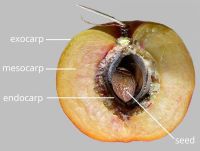 is often differentiated into layers, which may be woodywoody:
is often differentiated into layers, which may be woodywoody:
texture—consisting mainly of indurate lignified tissues, characteristic of or resembling wood
, fleshy, or mucilaginousmucilaginous:
resembling mucilage; moist and sticky
. The endocarpendocarp:
the inner layer of the pericarp, if divided into layers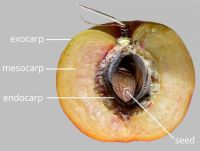 is membranousmembranous:
is membranousmembranous:
texture—extremely thin, pliable, and fairly tough
, hard and woodywoody:
texture—consisting mainly of indurate lignified tissues, characteristic of or resembling wood
, or soft or pulpy fleshy, sometimes becoming hard when dry. All fruits have a mucilaginousmucilaginous:
resembling mucilage; moist and sticky
pulp surrounding the seeds. In Citrus, the exocarpexocarp:
outer layer of fruit wall or pericarp, if divided into layers; note here used synonymously with epicarp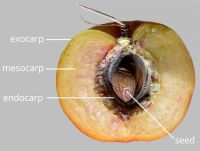 is thin and waxy. The mesocarpmesocarp:
is thin and waxy. The mesocarpmesocarp:
the middle layer of the pericarp, if divided into layers is often differentiated into three layers. The outermost layer is leatheryleathery:
is often differentiated into three layers. The outermost layer is leatheryleathery:
texture—moderately thick, tough, and very pliable
with often sunken, oil glands. The middle layer is thick and spongyspongy:
soft, light, discontinuous but cohesive, and somewhat resilient
, and the inner layer is white. Sometimes the mesocarpmesocarp:
the middle layer of the pericarp, if divided into layers is woodywoody:
is woodywoody:
texture—consisting mainly of indurate lignified tissues, characteristic of or resembling wood
. The endocarpendocarp:
the inner layer of the pericarp, if divided into layers is membranousmembranous:
is membranousmembranous:
texture—extremely thin, pliable, and fairly tough
and pulpy and/or resinous or gum-like.
Flindersioideae: Woodywoody:
texture—consisting mainly of indurate lignified tissues, characteristic of or resembling wood
capsulescapsule:
a dry, dehiscent fruit derived from a compound ovary .
.
Rutoideae: Thick-skinned and dry capsulescapsule:
a dry, dehiscent fruit derived from a compound ovary or schizocarpsschizocarp:
or schizocarpsschizocarp:
usually dry fruit splitting between two or more locules to form distinct, indehiscent, usually one seeded segments; fruit derived from a single, superior or inferior, compound ovary; compare to mericarp or thick-skinned and fleshy berriesberry:
or thick-skinned and fleshy berriesberry:
an indehiscent, fleshy fruit with one or a few to many seeds. The flesh may be homogenous throughout. Or, if the outer part is hard, firm, or leathery, referred to as an hesperidium. Septa are present in some, and the seeds may be arillate or with a fleshy testa. .
.
Spathelioideae: Dry capsulescapsule:
a dry, dehiscent fruit derived from a compound ovary and folliclesfollicle:
and folliclesfollicle:
a dry to (rarely) fleshy fruit derived from a single carpel that opens along a single longitudinal suture, derived from a single, superior, simple ovary; the seeds may be arillate or with a fleshy testa or fleshy drupesdrupe:
or fleshy drupesdrupe:
(indehiscent drupe) a fleshy, indehiscent fruit with one more hard pits enclosing seeds, derived from single, superior, simple or compound ovary; (dehiscent drupe) a fruit with a dry or fibrous to fleshy or leathery outer husk that early to tardily breaks apart (or opens), exposing one or more nutlike pits enclosing the seeds or drupeletsdrupelet:
or drupeletsdrupelet:
one drupe of a fruit with multiple drupes, as in blackberries
.
Toddalioideae: BerriesBerry:
an indehiscent, fleshy fruit with one or a few to many seeds. The flesh may be homogenous throughout. Or, if the outer part is hard, firm, or leathery, referred to as an hesperidium. Septa are present in some, and the seeds may be arillate or with a fleshy testa. , drupesdrupe:
, drupesdrupe:
(indehiscent drupe) a fleshy, indehiscent fruit with one more hard pits enclosing seeds, derived from single, superior, simple or compound ovary; (dehiscent drupe) a fruit with a dry or fibrous to fleshy or leathery outer husk that early to tardily breaks apart (or opens), exposing one or more nutlike pits enclosing the seeds , capsulescapsule:
, capsulescapsule:
a dry, dehiscent fruit derived from a compound ovary , samarassamara:
, samarassamara:
a winged, indehiscent, dry fruit containing a single (rarely two) seed(s) , folliclesfollicle:
, folliclesfollicle:
a dry to (rarely) fleshy fruit derived from a single carpel that opens along a single longitudinal suture, derived from a single, superior, simple ovary; the seeds may be arillate or with a fleshy testa , or schizocarpsschizocarp:
, or schizocarpsschizocarp:
usually dry fruit splitting between two or more locules to form distinct, indehiscent, usually one seeded segments; fruit derived from a single, superior or inferior, compound ovary; compare to mericarp of drupesdrupe:
of drupesdrupe:
(indehiscent drupe) a fleshy, indehiscent fruit with one more hard pits enclosing seeds, derived from single, superior, simple or compound ovary; (dehiscent drupe) a fruit with a dry or fibrous to fleshy or leathery outer husk that early to tardily breaks apart (or opens), exposing one or more nutlike pits enclosing the seeds or follicle-like fruits. The epicarpepicarp:
or follicle-like fruits. The epicarpepicarp:
outer layer of fruit wall or pericarp, if divided into layers; note here used synonymously with exocarp in these may be dry, leatheryleathery:
in these may be dry, leatheryleathery:
texture—moderately thick, tough, and very pliable
, fleshy, woodywoody:
texture—consisting mainly of indurate lignified tissues, characteristic of or resembling wood
, or membranousmembranous:
texture—extremely thin, pliable, and fairly tough
; mesocarpmesocarp:
the middle layer of the pericarp, if divided into layers fleshy or woodywoody:
fleshy or woodywoody:
texture—consisting mainly of indurate lignified tissues, characteristic of or resembling wood
; endocarpendocarp:
the inner layer of the pericarp, if divided into layers often cartilaginouscartilaginous:
often cartilaginouscartilaginous:
texture—firm, dense, tough, somewhat pliable, and resilient, like cartilage
or undifferentiated.
Seeds globoseglobose:
3D shape—more or less spherical to irregular, sometimes with fold between cotyledons and hypocotyl-radicle or notched, raphaeraphe:
to irregular, sometimes with fold between cotyledons and hypocotyl-radicle or notched, raphaeraphe:
a ridge or seam on the seed coat, formed by the portion of the funiculus united to the ovule wall in longitudinally curved ovules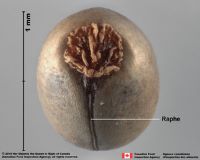 sometimes conspicuous, compressedcompressed:
sometimes conspicuous, compressedcompressed:
flattened; in grasses, used to denote compression (not necessarily flattened) either laterally or dorsiventrally
or flattened in transection, 1.5–60 mm long. Apically and/or dorsally winged (Flindersioideae, Spathelioideae, some genera in Toddalioideae). ArilsAril:
(broad sense) appendicular structure that wholly or partly envelops a seed and is produced from or a modification of the funicle, raphe, or outer integument; usually fleshy or pulpy, sometimes spongy or tufted-capillate, often brightly colored or elaiosomeselaiosome:
or elaiosomeselaiosome:
a lipid and protein-rich fleshy structure attached to some seeds and fruits, it attracts ants which then disperse the disseminule (e.g., caruncle in the Euphorbiaceae, the aril (outgrowth of the funiculus) in the Fabaceae)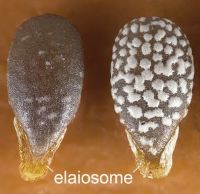 sometimes present. If present, arilsaril:
sometimes present. If present, arilsaril:
(broad sense) appendicular structure that wholly or partly envelops a seed and is produced from or a modification of the funicle, raphe, or outer integument; usually fleshy or pulpy, sometimes spongy or tufted-capillate, often brightly colored linear fleshy, brown, yellow, or white. Or vestigial arilsaril:
linear fleshy, brown, yellow, or white. Or vestigial arilsaril:
(broad sense) appendicular structure that wholly or partly envelops a seed and is produced from or a modification of the funicle, raphe, or outer integument; usually fleshy or pulpy, sometimes spongy or tufted-capillate, often brightly colored (pellicles), red or black. Sometimes spongy-fleshy sarcotestassarcotesta:
(pellicles), red or black. Sometimes spongy-fleshy sarcotestassarcotesta:
pulpy or fleshy outer layer of the seed coat, simulates aril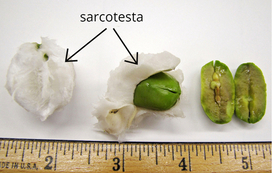 present. Seed coat black, bluish black, purplish, brown, gray, green, red, yellow, or white, sometimes spotted or mottledmottled:
present. Seed coat black, bluish black, purplish, brown, gray, green, red, yellow, or white, sometimes spotted or mottledmottled:
with colored spots, streaks, or blotches of a different color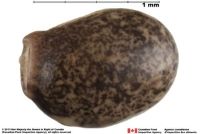 , dulldull:
, dulldull:
reflecting only a low proportion of incident light, with no apparent sheen or shinyshiny:
or shinyshiny:
uniformly reflecting a high proportion of incident light at all angles , glabrousglabrous:
, glabrousglabrous:
without hairs
or pubescent, leatheryleathery:
texture—moderately thick, tough, and very pliable
, scalyscaly:
surface relief—covered with small, thin, fine scales or flakes that may be removable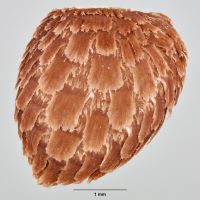 , fleshy (spongyspongy:
, fleshy (spongyspongy:
soft, light, discontinuous but cohesive, and somewhat resilient
), hard, paperypapery:
texture—papyraceous, chartaceous; very thin, pliable, and readily torn; like paper
, or membranousmembranous:
texture—extremely thin, pliable, and fairly tough
, glabrousglabrous:
without hairs
or pubescent, sometimes densely so, smooth or groovedgrooved:
surface relief—linear depressions that may be single or form a series of grooves over the surface , ridgedridged:
, ridgedridged:
surface relief—raised, thick ridges, sharp edged or rounded, usually in a series that may cover the entire surface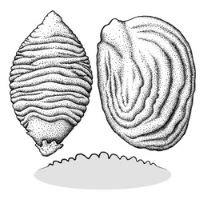 , wrinkledwrinkled:
, wrinkledwrinkled:
surface relief—shallow, irregular folds and furrows covering the surface; appearing overall though crumpled and then spread out , wartywarty:
, wartywarty:
surface relief—distinct, rounded projections that are large relative to the fruit size; tuberculate, verrucose , granulargranular:
, granulargranular:
surface relief—having a grainy surface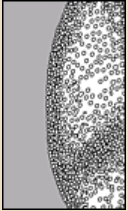 , reticulatereticulate:
, reticulatereticulate:
surface relief—netted, raised walls or concave grooves forming a net-like surface pattern with flat, concave, or convex interspaces , alveolatealveolate:
, alveolatealveolate:
surface relief—reticulated, honeycombed; ridges that intersect to form polygonal cells with a regular size and shape similar to a honeycomb , bubbled, or papillatepapillate:
, bubbled, or papillatepapillate:
surface relief—bearing minute, distinct, broad-based projections, tapering to a rounded apex . Inner layer of seed coat often with thick, dense, black sclerenchyma. In Aurantioideae, seed coat fibrousfibrous:
. Inner layer of seed coat often with thick, dense, black sclerenchyma. In Aurantioideae, seed coat fibrousfibrous:
texture—long, flexible threads, thicker than hairs, that densely cover and obscure the surface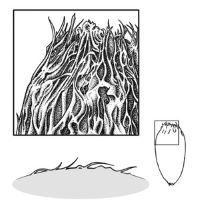 and mucilaginousmucilaginous:
and mucilaginousmucilaginous:
resembling mucilage; moist and sticky
. HilaHilum:
on seeds, the scar indicating where the funiculus was attached; on grass caryopses, the scar visible on the outer fruit surface revealing where the seed is attached on the inner fruit wall surface; or in Asteraceae cypselae, the scar visible on the outer fruit wall revealing where the fruit was attached to the receptacle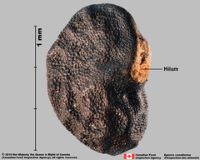 often larger than punctatepunctate:
often larger than punctatepunctate:
surface relief - dotted with pits or with translucent, sunken glands or with colored dots, similar to pitted , linearlinear:
, linearlinear:
(shape) long, narrow, and uniform in width; (of embryo) embryo is straight and much longer than wide , ellipticelliptic:
, ellipticelliptic:
2D shape—oval, oblong-like with the 2 ends narrowing and more or less alike
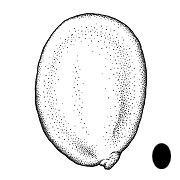 , or circularcircular:
, or circularcircular:
(of embryo) linear embryo is curved into an "O" shape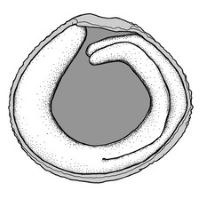 , short as or as long as seed, rarely a large cavity. In some genera, seed coat forms a subhilar rumination (bump or groove) near hilumhilum:
, short as or as long as seed, rarely a large cavity. In some genera, seed coat forms a subhilar rumination (bump or groove) near hilumhilum:
on seeds, the scar indicating where the funiculus was attached; on grass caryopses, the scar visible on the outer fruit surface revealing where the seed is attached on the inner fruit wall surface; or in Asteraceae cypselae, the scar visible on the outer fruit wall revealing where the fruit was attached to the receptacle .
.
Embryo well developed, completely to nearly completely filling seed coat, sometimes more than one per seed, relatively large, sometimes green, axileaxile:
on or of the axis
and centric, rarely peripheralperipheral:
(of embryo) embryo is curved around the outer edge of the seed, near the seed coat
(Cneoridium), foliatefoliate:
appearing leaf-like
, linearlinear:
(shape) long, narrow, and uniform in width; (of embryo) embryo is straight and much longer than wide , or ellipticelliptic:
, or ellipticelliptic:
2D shape—oval, oblong-like with the 2 ends narrowing and more or less alike
 , straight or curvedcurved:
, straight or curvedcurved:
(of embryo) linear embryo is curved into an arch or horseshoe with the ends far apart , with spatulatespatulate:
, with spatulatespatulate:
2D shape—like a spatula; rounded at the apex, with base long and tapered; (of embryo) embryo is straight and axile and centric with the cotyledons expanded to form the shape of a spatula or spoon; (of cotyledons) cotyledons expanded and wider than the stalk but not invested into the stalk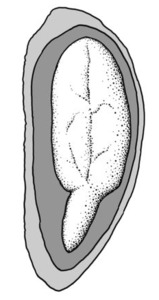 or investinginvesting:
or investinginvesting:
(of embryo) embryo is nearly or completely filling seed coat, straight, and axile and centric with spatulate cotyledons and covering the stalk for at least half its length; (of cotyledons) cotyledons spatulate and covering the stalk for at least half its length
cotyledons. Cotyledons thin to thick, flat and folded.
Endosperm copious, scanty, or absent, if copious, soft or hard fleshy, smooth.
| Fruit | |
| Type | berryberry: an indehiscent, fleshy fruit with one or a few to many seeds. The flesh may be homogenous throughout. Or, if the outer part is hard, firm, or leathery, referred to as an hesperidium. Septa are present in some, and the seeds may be arillate or with a fleshy testa.  (hesperidiumhesperidium: (hesperidiumhesperidium:a specialized berry, derived from a compound ovary, in which the outer layer is hard, firm, or leathery  ), drupedrupe: ), drupedrupe:(indehiscent drupe) a fleshy, indehiscent fruit with one more hard pits enclosing seeds, derived from single, superior, simple or compound ovary; (dehiscent drupe) a fruit with a dry or fibrous to fleshy or leathery outer husk that early to tardily breaks apart (or opens), exposing one or more nutlike pits enclosing the seeds  , samarasamara: , samarasamara:a winged, indehiscent, dry fruit containing a single (rarely two) seed(s)  , loculicidalloculicidal: , loculicidalloculicidal:type of capsular dehiscence, opening longitudinally through the locules (compare septicidal)  capsulecapsule: capsulecapsule:a dry, dehiscent fruit derived from a compound ovary  , rarely septicidalsepticidal: , rarely septicidalsepticidal:type of capsular dehiscence, opening longitudinally by separating between the septa of adjacent carpels  , folliclefollicle: , folliclefollicle:a dry to (rarely) fleshy fruit derived from a single carpel that opens along a single longitudinal suture, derived from a single, superior, simple ovary; the seeds may be arillate or with a fleshy testa  , or schizocarpschizocarp: , or schizocarpschizocarp:usually dry fruit splitting between two or more locules to form distinct, indehiscent, usually one seeded segments; fruit derived from a single, superior or inferior, compound ovary; compare to mericarp  splitting into drupeletsdrupelet: splitting into drupeletsdrupelet:one drupe of a fruit with multiple drupes, as in blackberries or follicle-like fruits |
| Size range | 2.5 - 150 mm long |
| Shape(s) | globoseglobose: 3D shape—more or less spherical  , ellipsoidellipsoid: , ellipsoidellipsoid:3D shape—elliptic , oblongoblong: 2D shape—much longer than broad with nearly parallel sides, corners are rounded  , ovoidovoid: , ovoidovoid:3D shape—ovate  , cylindriccylindrical: , cylindriccylindrical:3D shape—a cylinder, with parallel sides and a circular cross-section; tubular or rod-shaped , angularangular: 2D shape—having sides that meet at acute or obtuse angles (pentagonous, cuboidal, quadrangularquadrangular: 2D shape - four-sided, as in a square or rectangle  ), pyriform, rarely lobed, reniformreniform: ), pyriform, rarely lobed, reniformreniform:2D or 3D shape—kidney-shaped  , lunate or mitriform , lunate or mitriform |
| Texture | leatheryleathery: texture—moderately thick, tough, and very pliable , woodywoody: texture—consisting mainly of indurate lignified tissues, characteristic of or resembling wood , fleshy, chartaceouschartaceous: papery, papyraceous , membranousmembranous: texture—extremely thin, pliable, and fairly tough |
| Surface relief | smooth, gland-dotted, groovedgrooved: surface relief—linear depressions that may be single or form a series of grooves over the surface  , keeledkeel: , keeledkeel:a longitudinal ridge, like the keel of a boat, formed by the lengthwise folding of a structure, such as a lemma or palea  , ribbedribbed: , ribbedribbed:surface relief—wide, prominent, linear ridges that are generally rounded and longitudinally situated on the surface  , wartywarty: , wartywarty:surface relief—distinct, rounded projections that are large relative to the fruit size; tuberculate, verrucose  (small to large warts), wrinkledwrinkled: (small to large warts), wrinkledwrinkled:surface relief—shallow, irregular folds and furrows covering the surface; appearing overall though crumpled and then spread out  , pittedpitted: , pittedpitted:surface relief—surface with small depressions in which the areas between the hollows do not take on the appearance of a true reticular net  , punctatepunctate: , punctatepunctate:surface relief - dotted with pits or with translucent, sunken glands or with colored dots, similar to pitted  , with hornshorn: , with hornshorn:a straight or curved, slenderly conic or conoidal protrusion, resembling an animal horn or prickles |
| Color(s) | blue, black, purple, green, red, orange, yellow, cream |
| Unique features | Fruits highly variable. Brightly colored berriesberry: an indehiscent, fleshy fruit with one or a few to many seeds. The flesh may be homogenous throughout. Or, if the outer part is hard, firm, or leathery, referred to as an hesperidium. Septa are present in some, and the seeds may be arillate or with a fleshy testa.  with leatheryleathery: with leatheryleathery:texture—moderately thick, tough, and very pliable rinds dotted with sunken oil glands and compressedcompressed: flattened; in grasses, used to denote compression (not necessarily flattened) either laterally or dorsiventrally or flattened mucilaginousmucilaginous: resembling mucilage; moist and sticky seeds embedded in pulpy or resinous gummy-pulp are often encountered. |
| Seed | |
| Size range | 1.5 - 60 mm long |
| Shape(s) | globoseglobose: 3D shape—more or less spherical  , hemisphericalhemispherical: , hemisphericalhemispherical:2D shape—shaped like half a sphere , ellipsoidellipsoid: 3D shape—elliptic , lens-shapedlens-shaped: 2D shape—round and flattened with two curved (convex) surfaces , ovoidovoid: 3D shape—ovate  , pyriform, conicalconical: , pyriform, conicalconical:3D shape—cone-shaped, with the point of attachment at the broad end 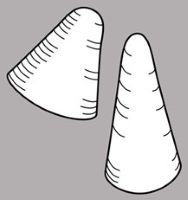 , wedge-shapedwedge-shaped: , wedge-shapedwedge-shaped:2D shape—triangular and tapering to a point at the base 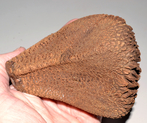 , tear-shaped, cuboidal, angledangular: , tear-shaped, cuboidal, angledangular:2D shape—having sides that meet at acute or obtuse angles , reniformreniform: 2D or 3D shape—kidney-shaped  , irregular, U-shaped (Cneoridium) , irregular, U-shaped (Cneoridium) |
| Surface relief | smooth, groovedgrooved: surface relief—linear depressions that may be single or form a series of grooves over the surface  , ridgedridged: , ridgedridged:surface relief—raised, thick ridges, sharp edged or rounded, usually in a series that may cover the entire surface  , wrinkledwrinkled: , wrinkledwrinkled:surface relief—shallow, irregular folds and furrows covering the surface; appearing overall though crumpled and then spread out  , wartywarty: , wartywarty:surface relief—distinct, rounded projections that are large relative to the fruit size; tuberculate, verrucose  , granulargranular: , granulargranular:surface relief—having a grainy surface  , reticulatereticulate: , reticulatereticulate:surface relief—netted, raised walls or concave grooves forming a net-like surface pattern with flat, concave, or convex interspaces  , alveolatealveolate: , alveolatealveolate:surface relief—reticulated, honeycombed; ridges that intersect to form polygonal cells with a regular size and shape similar to a honeycomb  , bubbled, papillatepapillate: , bubbled, papillatepapillate:surface relief—bearing minute, distinct, broad-based projections, tapering to a rounded apex  |
| Color(s) | black, bluish black, purplish, brown, gray, green, red, yellow, white, sometimes spotted or mottledmottled: with colored spots, streaks, or blotches of a different color  |
| Unique features | Seeds often compressedcompressed: flattened; in grasses, used to denote compression (not necessarily flattened) either laterally or dorsiventrally or flattened with large, variously shaped hilahilum: on seeds, the scar indicating where the funiculus was attached; on grass caryopses, the scar visible on the outer fruit surface revealing where the seed is attached on the inner fruit wall surface; or in Asteraceae cypselae, the scar visible on the outer fruit wall revealing where the fruit was attached to the receptacle  and well developed, large, sometimes green embryos with thin to thick, flat and folded cotyledons, often embedded in endosperm. In some genera, more than one embryo per seed. and well developed, large, sometimes green embryos with thin to thick, flat and folded cotyledons, often embedded in endosperm. In some genera, more than one embryo per seed. |
| Other | |
| Embryo | well developed, completely to nearly completely filling seed coat, sometimes more than one per seed, relatively large, sometimes green, axileaxile: on or of the axis and centric, rarely peripheralperipheral: (of embryo) embryo is curved around the outer edge of the seed, near the seed coat (Cneoridium), foliatefoliate: appearing leaf-like , linearlinear: (shape) long, narrow, and uniform in width; (of embryo) embryo is straight and much longer than wide  , or ellipticelliptic: , or ellipticelliptic:2D shape—oval, oblong-like with the 2 ends narrowing and more or less alike  , straight or curvedcurved: , straight or curvedcurved:(of embryo) linear embryo is curved into an arch or horseshoe with the ends far apart  , with spatulatespatulate: , with spatulatespatulate:2D shape—like a spatula; rounded at the apex, with base long and tapered; (of embryo) embryo is straight and axile and centric with the cotyledons expanded to form the shape of a spatula or spoon; (of cotyledons) cotyledons expanded and wider than the stalk but not invested into the stalk  or investinginvesting: or investinginvesting:(of embryo) embryo is nearly or completely filling seed coat, straight, and axile and centric with spatulate cotyledons and covering the stalk for at least half its length; (of cotyledons) cotyledons spatulate and covering the stalk for at least half its length cotyledons. Cotyledons thin to thick, flat and folded. |
| Nutritive tissue | endosperm copious, scanty, or absent, if copious, fleshy-soft or -hard, smooth |
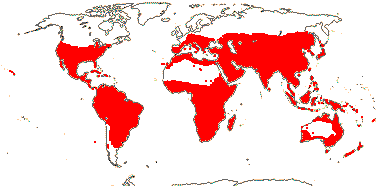
Distribution map courtesy of Angiosperm Phylogeny Website.
Appelhans et al. 2021Appelhans et al. 2021:
Appelhans MS, Bayly MJ, Heslewood MM, Groppo M, Verboom GA, Forster PI, Kallunki JA, and Duretto MF. 2021. A new subfamily classification of the Citrus family (Rutaceae) based on six nuclear and plastid markers. TAXON 70: 1035&-1061. https://doi.org/10.1002/tax.12543; Bayly et al. 2013Bayly et al. 2013:
Bayly MJ, Holmes GD, Forster PI, Cantrill DJ, Ladiges PY. 2013. Major Clades of Australasian Rutoideae (Rutaceae) Based on rbcL and atpB Sequences. PLoS ONE 8(8): e72493. https://doi.org/10.1371/journal.pone.0072493; Cao et al. 2016Cao et al. 2016:
Cao M, Mou, F-J, Shah A, Rahim S, and Chen J-S. 2016. Seed morphology of Zanthoxylum (Rutaceae) in China and its systematic significance. Pakistan Journal of Botany 48: 223&-230.; Choi et al. 2012Choi et al. 2012:
Choi B-K, Duretto MF, Hong S-P. 2012. Comparative seed morphology of Boronia and related genera (Boroniinae: Rutaceae) and its systematic implications. Nordic Journal of Botany 30: 241&-256.; Duretto 1997Duretto 1997:
Duretto MF. 1997. Taxonomic notes on Boronia species of north-western Australia, including a revision of the Boronia lanuginosa group (Boronia section Valvatae: Rutaceae). Nuytsia 11: 301&-346.; Duretto 2018Duretto 2018:
Duretto MF. 2018. Drummondita borealis Duretto (Rutaceae), a new species from the Northern Territory, and a revised description for D. calida (F.Muell.) Paul G.Wilson from Queensland. Austrobaileya 10(2): 236&-241.; Flora of Australia 2021+Flora of Australia 2021+:
Flora of Australia. Australian Biological Resources Study, Canberra. Accessed January 2021–March 2024. URL: http://www.ausflora.org.au; George 1971George 1971:
George AS. 1971. A new species of Philotheca, P. tubiflora - the first record of the genus, sensu stricto, for Western Australia. Nuytsia 1(2): 208&-209.; Hartley 1977Hartley 1977:
Hartley T. 1977. A Revision of the Genus Bosistoa (Rutaceae). Journal of The Arnold Arboretum 58: 416&-436; Hartley 1986Hartley 1986:
Hartley TG. 1986. Three new species of Sarcomelicope (Rutaceae) from New Caledonia (with a key to the species of the genus). Bulletin du Muséum d'Histoire Naturelle Section B, Adansonia 8: 183&-189.; Kirkbride et al. 2006Kirkbride et al. 2006:
Kirkbride JH, Jr, Gunn CR, and Dallwitz MJ. 2006. Family guide for fruits and seeds, vers. 1.0. Accessed September 2020-January 2022. URL: https://nt.ars-grin.gov/seedsfruits/keys/frsdfam/index.cfm .; Kubitzki et al. 1990+Kubitzki et al. 1990+:
Kubitzki K et al., eds. 1990+. The families and genera of vascular plants. 7+ vols. Berlin etc.; Meissner and Markey 2007Meissner and Markey 2007:
Meissner RA and Markey AS. 2007. Two new Western Australian species of Drummondita (Rutaceae: Boronieae) from banded ironstone ranges of the Yilgarn Craton. Nuytsia 17: 273&-280.; Mollemans 1993Mollemans 1993:
Mollemans FH. 1993. Drummondita wilsonii, Philotheca langei and P. basistyla (Rutaceae), new species from south-west Western Australia. Nuytsia 9(1): 95&-109.; Shelton and Thiele 2022Shelton and Thiele 2022:
Shelton LRJ and Thiele KR. 2022. Drummondita billyacatting (Rutaceae), a new, range-restricted species from Western Australia. Nuytsia 33: 19&-27.; Takhtajan 2009Takhtajan 2009:
Takhtajan A. 2009. Flowering plants: Second edition. Springer Nature, Switzerland. 871 pp.; Wilson 1971Wilson 1971:
Wilson PG. 1971. Taxonomic notes on the family Rutaceae, principally of Western Australia. Nuytsia 1(2): 197&-207.; Zhengyi et al. 2004+Zhengyi et al. 2004+:
Zhengyi W, Raven PH, and Deyuan H. 2004+. Flora of China [online]. 25 vols. Science Press, Beijing China & Missouri Botanical Garden, St. Louis USA. Accessed January–March 2024. http://flora.huh.harvard.edu/china/
*The number of genera and species is based on Christenhusz and Byng 2016Christenhusz and Byng 2016:
Christenhusz MJM and Byng JW. 2016. The number of known plant species in the world and its annual increase. Phytotaxa 261 (3): 201-217. https://doi.org/10.11646/phytotaxa.261.3.1, which may differ from the number of genera in GRIN-Global.